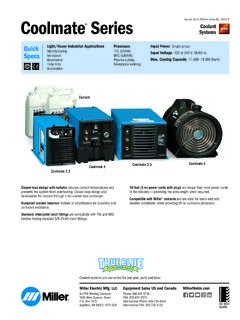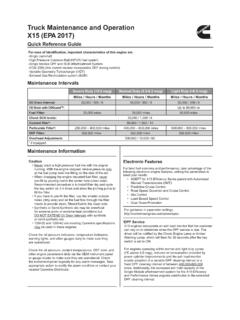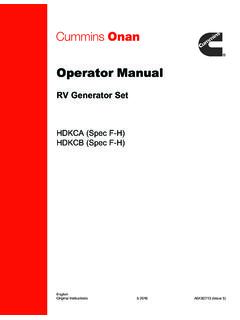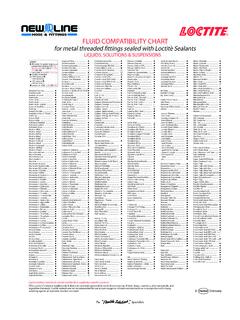Transcription of GUIDE TO COOLANT ANALYSIS AND COOLING SYSTEM …
1 GUIDE TO COOLANT ANALYSIS AND COOLING SYSTEM MAINTENANCECOOLANT MAINTENANCEToo LowToo High Too LowToo High SPECIFICATIONS Antifreeze level will vary by OEM specifications, application and elevation at which the SYSTEM operates Engines operating at 195 or above must be at 50% for boil point control Engines operating at 10,000 ft. and above should maintain a 55-60% antifreeze level to prevent COOLANT boiling Marine applications should maintain 30-60% antifreeze if the SYSTEM operates above 195 SPECIFICATIONS Conventional COOLANT : to 11 ELC Formulation: typically to ; if pH is above , possible ELC and conventional COOLANT mixing Correct cause of drop in pHNOTE: Sample appearance alone does not determine whether a potentially harmful problem exists within the COOLING CAUSE Improper mixing of bulk COOLANT Topping off with water only Improper mixing of bulk COOLANT Topping off with glycol concentrate Evaporation of waterPOTENTIAL DAMAGE Internal boiling Frozen and cracked block Cavitation and pitting Loss of heat transfer Cavitation Pitted liners Seals may failNOTE: Test package selection should be based on application, OEM COOLANT formulation and program goals.
2 Automotive, Light Duty & Heavy Duty engines ethylene glycol , propylene glycol or glycerin base Inorganic inhibitor package for metal corrosion and cavitation pitting protectionComponentsTypical Color: Green/Yellow, Pink, Blue, PurpleEthylene/Propylene glycol or Glycerin based Freeze point suppression Boil point elevationBorate Iron protection pH bufferNitrate Aluminum and solder corrosion protectionNitrite Cast iron and steel corrosion protectionPhosphate Iron protection pH controlSilicate Aluminum corrosion protection Azoles (Mercaptobenzothiazole - MBT, Tolytriazole TTZ or Benzothiazole - BZT) Yellow metal protection (copper & brass)Silicon & Block Polymers Defoamant Scale and deposit controlSCA & Water Marine engines, Locomotives, COOLING towers Inorganic inhibitor package for metal corrosion and cavitation pitting protection General use in India, China, Brazil, Mexico, etc.
3 General recommendation is to not use where there is a chance of freezingRecommendations Sample high hour/mileage or high asset engines quarterly Sample engines less critical to production semi-annually Monitor glycol , nitrite, molybdenum and pH levels at every PM High glycol could indicate an air leak that is allowing the water in the COOLANT to evaporate due to excessive under-hood heat Submit samples with a significant drop in SCA for laboratory testing to determine causeTest PackageStandard Conventional COOLANT Visuals (color, foam, oil, fuel, magnetic precipitate, non-magnetic precipitate, & odor) pH glycol % Freeze Point Nitrite SCA Number Total Hardness Specific Conductance Corrosion Metals & Inhibitors by ICP (Iron, Copper, Aluminum, Lead, Tin, Zinc, Silver, Calcium, Mag-nesium, Borate, Silicon, Molybdenum, Phosphorus, Potassium, Sodium)Premium Conventional COOLANT Standard Conventional COOLANT test package plus: Contaminant and Inhibitor Anions by IC (Fluoride, Chloride, Sulfate, Nitrite, Nitrate, Phosphate, Glycolate, Formate, Acetate, Oxalate)(1st Generation)(OAT, NOAT & HOAT) Organic Acid Technology (OAT) Typical color: Orange Automotive and Light Duty Controls corrosionNitrite Organic Acid Technology (NOAT) Typical color.
4 Red/Orange Heavy Duty engines Nitrite added for cavitation corrosion protectionHybrid Organic Acid Technology (HOAT) Typical color: Fluorescent Yellow Automotive and Diesel engines Combination of conventional and OAT technologies Not restricted to any particular type of additive Low-Silicate and Phosphate free ComponentsEthylene glycol Freeze Point Suppression Boil Point ElevationPotassium Soap of Dibasic Carboxylic Acid Iron, Solder and Aluminum ProtectionPotassium Soap of Monobasic Carboxylic Acid Aluminum and Iron (w/sebacate) ProtectionNitrite Cast Iron and Steel ProtectionMolybdenum Iron Corrosion Protection (w/nitrite)Azoles (Mercaptobenzothiazole - MBT, Tolytriazole TTZ or Benzothiazole - BZT)Modified Silicone Defoamant Inhibit foaming tendenciesRecommendations Sample high hour/mileage or high asset engines quarterly Sample engines less critical to production semi-annually Monitor glycol , nitrite and pH levels at every PM When changing from a conventional to an extended life COOLANT , first flush the SYSTEM thoroughly unless using a conversion fluid - mixing the two degrades the benefit of using an ELCNOTE.
5 Components listed above do not reflect all com-ponents used in all ELCs manufacturedTest PackageStandard Extended Life COOLANT Visuals (color, foam, oil, fuel, magnetic precipitate, non-magnetic precipitate, & odor) pH glycol % Freeze Point Nitrite SCA Number Specific Conductance Carboxylic Acid Pass/Fail Total Hardness Corrosion Metals & Inhibitors by ICP (Iron, Copper, Aluminum, Lead, Tin, Zinc, Silver, Calcium, Magnesium, Borate, Silicon, Molybdenum, Phosphorus, Potassium, Sodium)Premium Extended Life COOLANT Standard ELC COOLANT test package plus: Contaminant and Inhibitor Anions by IC (Fluoride, Chloride, Sulfate, Nitrite, Nitrate, Phosphate, Glycolate, Formate, Acetate, Oxalate) Organic Acid and Azoles by HPLC(Benzoate, 2-Ethylhexanoic Acid, Sebacic Acid, Octanoic Acid, p-Toluic Acid, Mercaptobenzothiazole, Tolytriazole, Benzothiazole)(2nd Generation)(NAP-Free or NAPS-Free & P-OAT)North American & European Formulated Coolants Typical color.
6 Red Heavy- and light-duty diesel, natural gas, and gasoline engines Nitrite, Amine, Phosphate Free Combination of organic acids as inhibitor package Requires a different glycol curve than traditional coolantP-OAT (Asian Formulated Coolants) Typical color Red/Orange or Blue Heavy- and light-duty diesel, natural gas, and gasoline engines Nitrite, Amine, Borate & Silicate Free Includes Phosphates Combination of organic acids as inhibitor package Requires a different glycol curve than traditional coolantComponentsEthylene glycol Freeze Point Suppression Boil Point ElevationCarboxylic Acids Standard Benzoate, 2-Ethylhexanoic, Sebacic, Octanoic, p-toluic, Adipic or Dodecanedioic acid Iron, Solder and Aluminum ProtectionAzoles (Mercaptobenzothiazole - MBT, Tolytriazole TTZ or Benzothiazole - BZT)
7 Phosphate Iron protection pH controlModified Silicone Defoamant Inhibit foaming tendenciesRecommendations Sample high hour/mileage or high asset engines quarterly Sample engines less critical to production semi-annually Monitor glycol and pH levels at every PM Test organic acids by High Pressure Liquid Chromatography (HPLC) or test strip is necessary to determine suitability for continued use Mixing ELC COOLANT formulations with conventional COOLANT will degrade ELC benefits. If changing from a conventional to an ELC product flush the SYSTEM thoroughly first unless conversion fluid is used. COOLANT components listed above do not reflect all components utilized in all 2nd generation ELC coolants PackageStandard Extended Life COOLANT Visuals (color, foam, oil, fuel, magnetic precipitate, non-magnetic precipitate, & odor) pH glycol % Freeze Point Nitrite SCA Number Specific Conductance Carboxylic Acid Pass/Fail Total Hardness Corrosion Metals & Inhibitors by ICP (Iron, Copper, Aluminum, Lead, Tin, Zinc, Silver, Calcium, Magnesium, Borate, Silicon, Molybdenum, Phosphorus, Potassium, Sodium)Premium Extended Life COOLANT Standard ELC COOLANT test package plus.
8 Contaminant and Inhibitor Anions by IC (Fluoride, Chloride, Sulfate, Nitrite, Nitrate, Phosphate, Glycolate, Formate, Acetate, Oxalate) Organic Acid and Azoles by HPLC(Benzoate, 2-Ethylhexanoic Acid, Sebacic Acid, Octanoic Acid, p-Toluic Acid, Mercaptobenzothiazole, Tolytriazole, Benzothiazole)Conventional COOLANT Extended Life CoolantExtended Life COOLANT Antifreeze/ glycol %Visual Appearance Color should be clear and bright Should match the color of original COOLANT usedOil in COOLANT free from oil or petroleum products (can cause seal and hose failures)Non-Magnetic/Magnetic Precipitate free from precipitate, flocculent, algae, bacteria, and/or sludge (outside contaminants entering the SYSTEM or COOLANT chemical dropout); magnetic precipitate should be a trace or lessPROBABLE CAUSEC oolant mixing, glycol degradation, outside contaminants, precipitation oil cooler rubber seal or core leaks.
9 Combustion gas blow-by into the coolantimproper COOLANT use, over-inhibiting, defective electrical groundsPOTENTIAL DAMAGE loss of heat transfer, liner, hose and water pumpseal damage, block head water passageseal damagewater pump seal abrasion, scores soft metal surfaces (copper & aluminum), liner pitting around lower sealsCOOLANT FORMULATIONS & RECOMMENDED TEST PACKAGESPROBABLE CAUSE COOLANT is water only Source water does not meet engine manufacturer specifications ethylene glycol is beginning to degrade or COOLANT is burnt Combustion gas blow-by from cracked head, head gasket failure, perforated hole in cylinder liner, Acid type cleaner used and not flushed thoroughlyPOTENTIAL DAMAGE Corrosion on iron components as well as other metals in the SYSTEM Electrolysis pitting through liners Corrosive attack on engine block Possible corrosion protection chemicals precipitate out of solution COOLANT mixing of different formulations Severe aluminum corrosion.
10 Aluminum is an alkaline metal Overtreating the SYSTEM with SCAs Outside contaminant entering the SYSTEM Severe aluminum corrosion Inhibitor precipitationpHCOOLANT FORMULATIONS & RECOMMENDED TEST PACKAGES (continued)PROBABLE CAUSE Improper source water Combustion gas leak Antifreeze level too high Inhibitor level too high Inhibitor being added too many times over an extended period of time COOLANT mixingPOTENTIAL DAMAGE The inability of the COOLANT to resist carrying an electrical current between the dissimilar metals of an engine s COOLING SYSTEM Engine becomes a wet cell batterySpecific ConductancePROBABLE CAUSE Maintenance chemicals are not sufficient for metal protection and to prevent sludge from forming Air leak into the COOLING SYSTEM Combustion gas blow-by from cracked head, head gasket failure, perforated hole in cylin der liner, etc.





